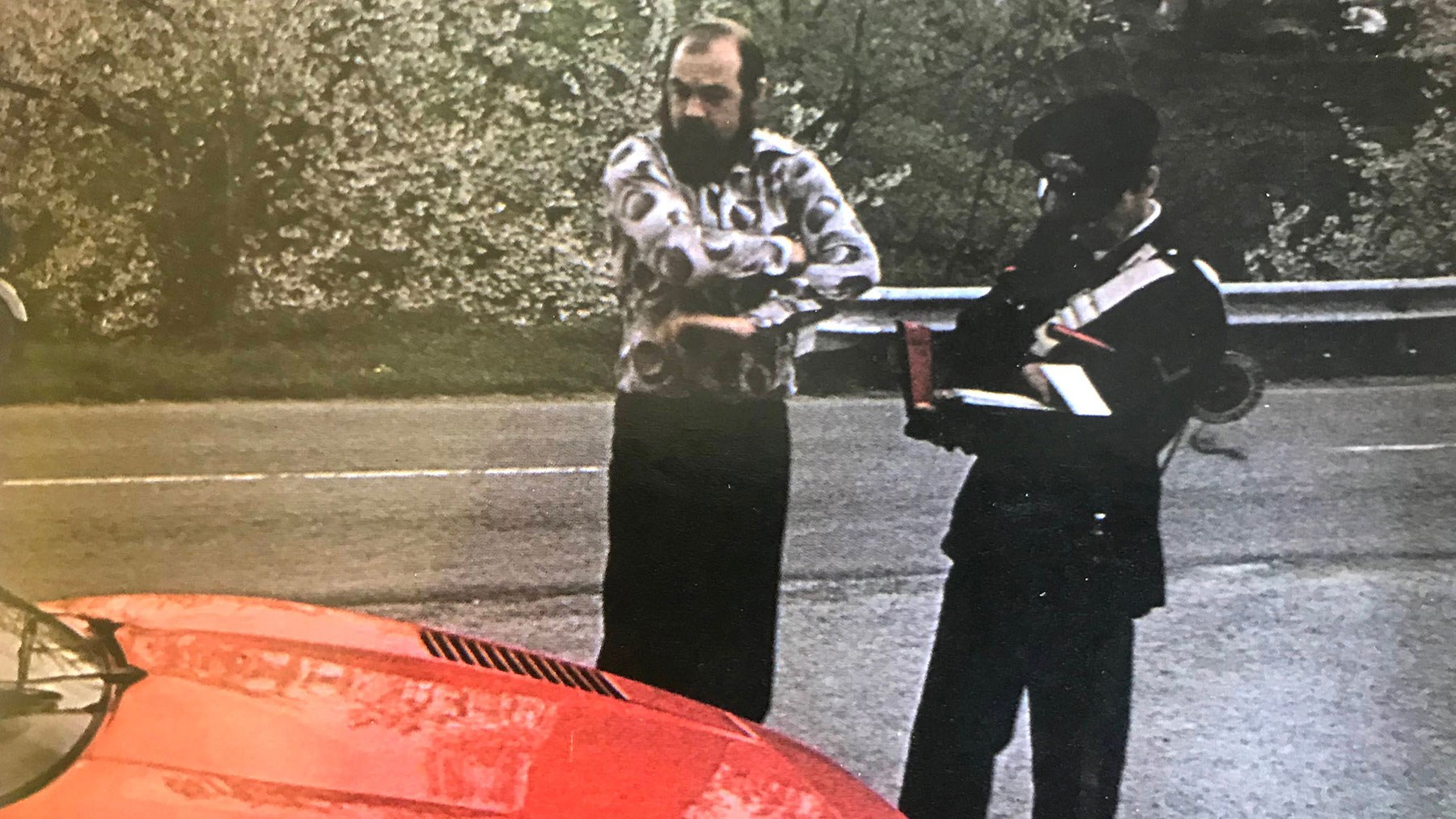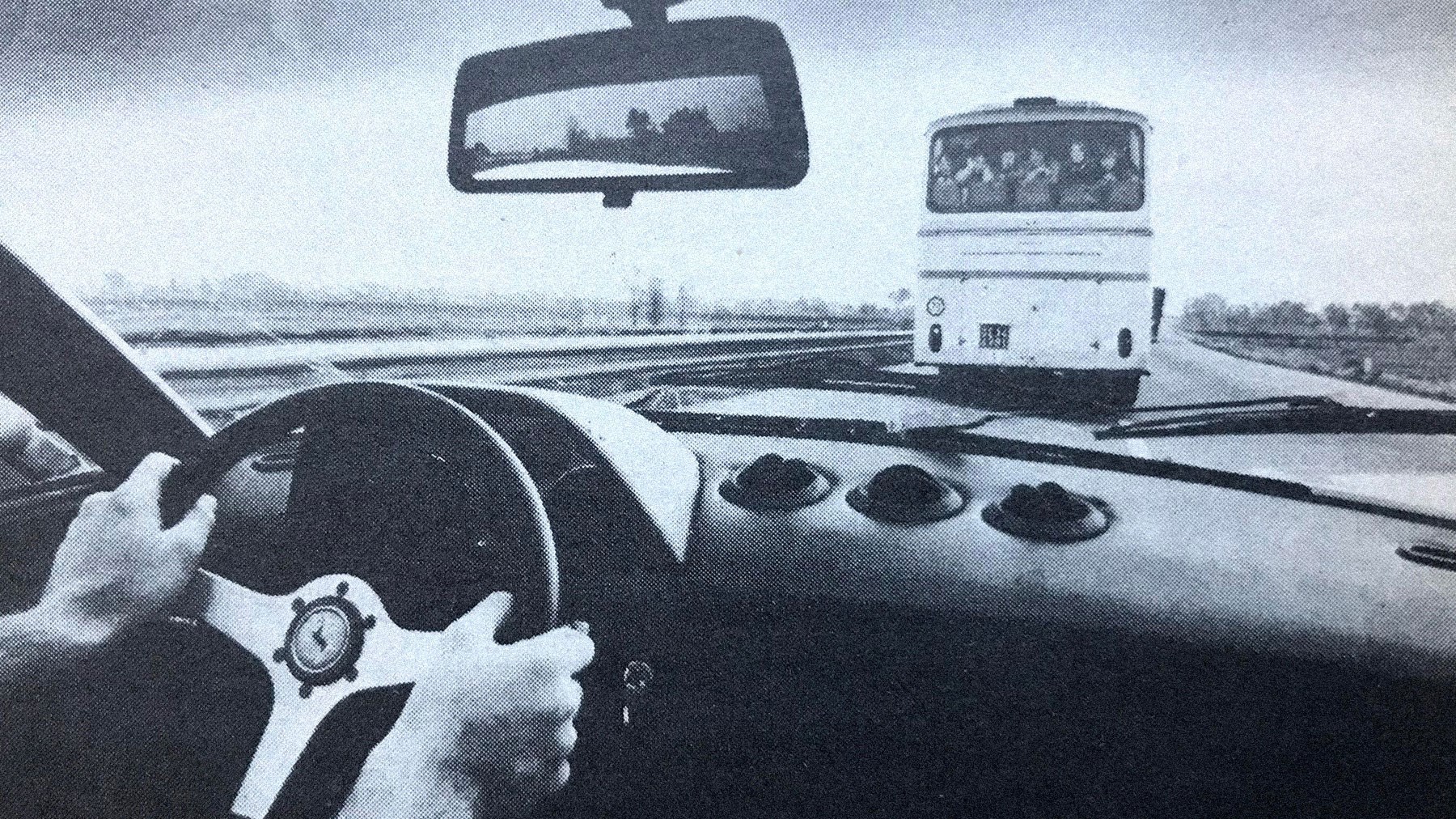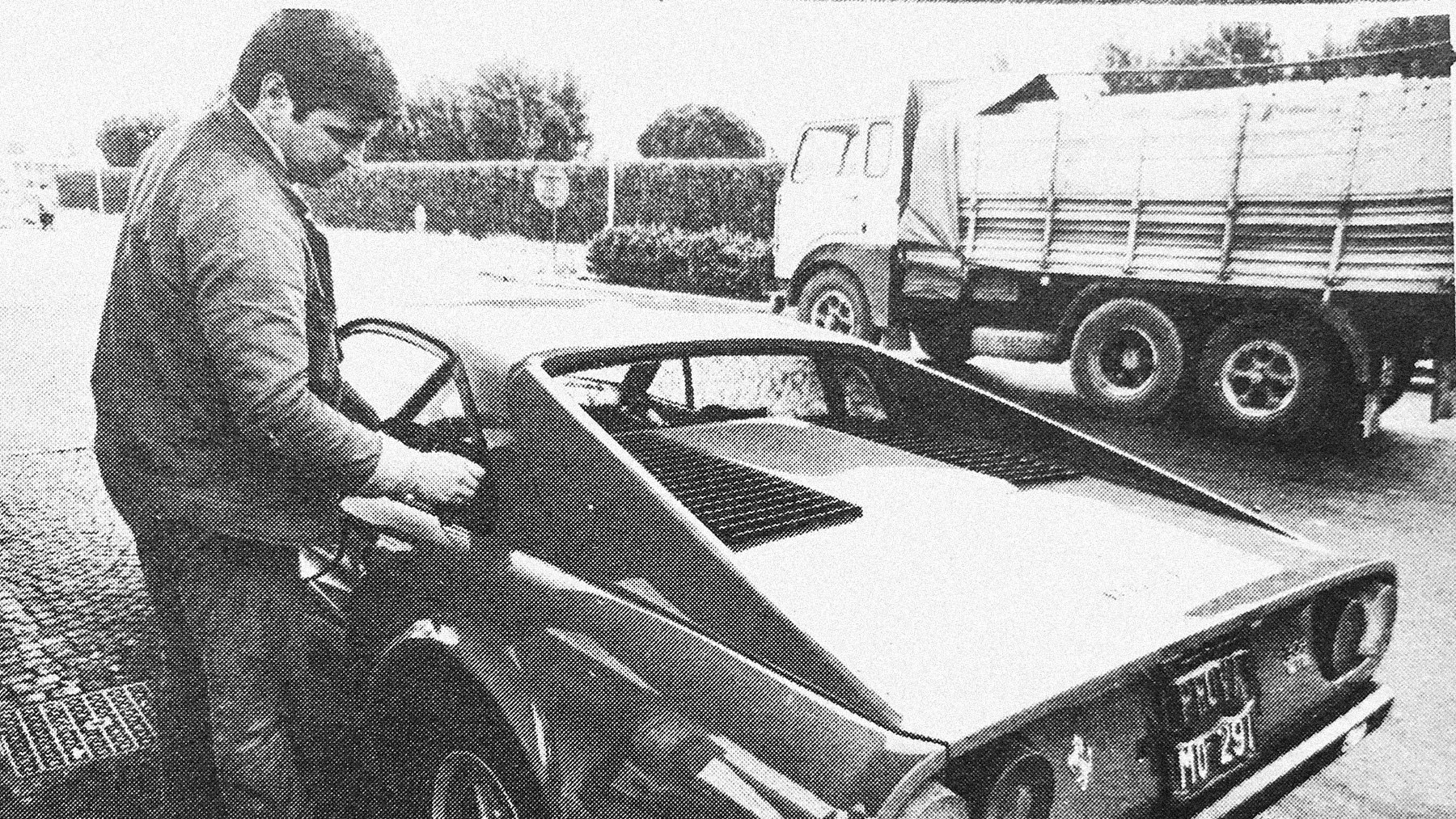► Ferrari 308 GTB first drive in July 1976
► All-new mid-engined sports car from Maranello
► Fast, capable, but watch out for the traffic police
We’ve opened the CAR archive to dig out some of the finest drive stories, Giant tests and launch coverage from our rich history. Here, former editor Mel Nichols has a brush with the law when driving the new Ferrari 308 GTB.
The Carabinieri were waiting at the top of the pass. They were hidden in a farm entrance around a tight right-hand bend, and I didn’t see them at all until it was much too late. Damn it, where had the radar trap been? How the hell was I going to worm out of this? Their ears alone would have told them everything.
They’d have heard the wailing of superlative little V8 rising and rising rising as it wound through four gears to culminate in a bellow as it touched 7500rpm. And then there’d have in pause and the smack as the next gear took up and it was all repeated, again and again.
Among the wha-room… wha-room… wha-room… of the next downward changes there’d have been the occasional squeal of a punished brake as the car was hauled down hard, Michelins scrabbling, for one of the tighter hairpins. For close to seven miles, by my reckoning, they must have been treated to this; and they must have been in no doubt that the red Ferrari now trickling to a stop at their command had been going very, very fast.
It is possible that once or twice, had they perhaps needed visual proof or indeed sought only to heighten the experience, they’d have been able to catch sight of it as it devoured the mountain beneath them, racing ever faster into their arms, a red streak against the lush green of early summer.
‘Documenti, Signor?
I got out. The younger policeman took charge: ‘Documenti, signor?‘ I gave him the wad of papers Ferrari had provided for me, hauled out my licence and told him what he already knew: that this Little red devil of a 308GTB was out on test from the factory, now more than 100 miles back through the mountains. He studied the papers for a long time, going slowly over each document. Then he replaced them carefully in their leather folder and handed them back. I made to get back in the car, but he waved me back with his ping-pong bat, and it was then that I thought I was in real trouble.
But no, he just wanted to peer inside, than walk slowly around it , admiring it from this angle and that. He said only one word: ‘magnifico,’ held out his hand and invited me to to take my place behind the little leather steering wheel. When the V8, after the high-pitched wheeze from the starter motor that is so characteristic of Ferraris, burst into life he summoned for me to blip it several times, and he shook his head slowly with appreciation and wonder and respect. ‘Buongiorno, signor,’ he said. ‘Arrividerci’ And then with a grin in the best English he could summon: ‘signor, you go more slow, eh?’
A disappointing soundtrack
Say what you like, a Ferrari is still a Ferrari. In fact, the 308GTB does not sound especially good from the outside. The 308 GT4 2+2 from which it is derived mechanically is not noted for its musical ability, but is rather more pleasing than its new sister which has the misfortune to sound more like a Lotus than a quad-cam V8. There is a reason: the exhaust pipes, in two bunches of four, are collected into two main pipes and these in turn feed into the one large silencer; the gas and the sound are then forced to emerge through only the one paltry outlet.

It is a different matter from inside the cabin, for this sort of concession to the latest market requirements, the sort of sophistication that Ferrari are now building into their cars, does not extend to absolute muffling. Even if they tried to keep the music from the driver’s ears, they’d stand little chance of succeeding.
The modestly oversquare 3.0-litre V8, sitting there transversely, is even closer to the occupants’ backs than in the GT4. Top it with twin cams on each bank, feed it with four twin-choke Weber carburettors, build most of it from light alloy, let it rev to 7700rpm and tune it to provide 255bhp and you get an engine that will not, should not, be silenced. The exhaust note might be lilly-livered, but the rest of the sounds that provide your first clue to the sheer excellence of the Ferrari 3.0-litre V8 are all there, even down to the just-audible sucking at the air intakes just aft of the doors.
Small and perfectly formed
Whereas the 308GTB bears a strong physical resemblance to the much-loved 246GT predecessor and is mechanically almost identical to the 308 GT4, it is a departure from both of them and from all previous production Ferrari practice: the body is glassfibre over a tubular steel chassis. Ferrari does not feel the need to make mention of this fact in the brochure nor, I suppose, should it. It is the finest plastic coachwork I have yet seen, and most people would never suspect that it is not metal.
The facts that emerge when one compares the three Dinos (discounting the original 206 and the current 208) show that the 308GTB represents a swing back to the concept and character of the beloved 246 – a small, light, fast and intensely personal two-seater. Gone is the compromise of the 2+2 but present are the lessons of greater sophistication and practicality gleaned from it.
Dimensionally, in all but width (where it is broader by a mere half-inch anyway) the 308GTB is actually smaller than the Dino 246. Fractionally so, but it is smaller. Interestingly enough it is not lighter. Of course, it has a significant weight advantage over the 308GT4 – 2403lb compared with 2576lb. And since both cars have precisely the same engine, the GTB has a decent edge over its 2+2 sister in its power-to-weight ratio: it has to pull 9.4lb/bhp compared with 10.1 (the 195bhp Dino 246’s figure was 12.2).
How fast is the Ferrari 308GTB?
Translate all this into on-the-road terms, into the barking of the engines, the howling of the cams, the sucking of the carburettors, the along with oil press chirp of the tyres and the slap of the thin metal gearlever in its clinical metal gate and the 308GTB forges firmly away from the GT4. It covers the standing quarter mile in 14.1secs instead of 14.4; it emerges from the standing kilometre at 136.7mph after a 25.4sec run instead of 131 mph and 26.2secs.
There’s another hint of the way Maranello, and indeed the market place, has been thinking to be found in the gearing. The final drive and the first four ratios in the gearbox that nestles beneath the V8 are identical for the two 308s. Take them to 7000rpm, the power peak but not the absolute rev limit, in those first four gears and both will provide you with a potent 41, 59, 83 and 112mph.
But in the GTB Ferrari, freed from the need to actually make the GTB achieve a higher top speed than the GT4, have raised fifth gear to provide pleasant trim material instead for more economical cruising. The GTB’s weight advantage means that the new car will still in fact accelerate quicker in top anyway. The difference in the final gearing in fifth isn’t great – 21.6mph/1000rpm rather than 21.08, but identical top speeds of 156mph you’ll have 7250rpm on the GTB’s tachometer while in the GT4 is looking at 7400rpm.
First impressions
Like the 308 GT4, the new GTB is at once a very easy car to drive; it puts you at ease. There is the same taut but undemanding drivetrain with a clutch that has plenty of firmness to its springing but not too much weight and a gearshift that moves with the sort of chunky metal-to-metal deliberation that one has come to expect. There is the same lack of fuss from the 3.0-litre V8, the same instant response and the same magnificent flexibility. There is no flab about any of the functions with which you must deal in the GTB; you must get into it, feel so very much at home, and get on with the job.
The driving position is low, but quite ‘normal’. There’s the usual Italian rake to the wheel, but the positioning is fine and the distance from the seat to the rim and to the pedals makes for immediate comfort. The instruments are arranged differently from the 308GT4 – there is a rather tall binnacle jutting up from the fascia, and deeply hooded. Big, simply marked speedo and tachometer reside there, along with oil pressure, water temperature and fuel gauges. A Clock and the oil temperature gauge are tucked away on the lower extremity of the dash where you won’t see either in a hurry.
Visual access to the main instruments is excellent, but Ferrari spoiled it by failing to eliminate reflections on their faces. Three stalks operate the minor controls, and toggles for the auxiliaries, the air conditioning knobs and the heater/ventilator slides are grouped on the little central console just behind the gear lever. The cabin is very much like the Boxer’s, but perhaps a bit neater and more elegantly simple. There is an unusual appeal about the way the long, thin armrests on the doors mate up at their forward ends with the edges of the dashboard, and although the cabin isn’t very big there is an air of sufficient spaciousness to it thanks to the use of pleasant trim materials.

Hitting the road in Ferrari’s tearaway
Does the 308 GTB really do as Ferrari claim? Of course it does! After being given carte-blanche by the Carabinieri, after being waved on by another group a couple of hundred miles later I pelted through the Futa Pass – what joy! – I rejoined the motorway from Bologna back to Modena and after watching a Daytona closing steadily on me as I sat on a relaxed 130mph.
Then I saw him disappear into the distance at something well in excess of 160mph. He seemed to have no apparent concern on the face I saw in his mirror. In response, I opened the GTB right up. It answers like the thoroughbred that it is. It surges forward with spirit, the tachometer and speedometer needles climbing in unison, and the sound behind your head growing more and more intense, until there is just no more to come.
In fact, the speedo was reading just over 160mph, but the tachometer said it was incorrect. At this speed, like the GT4, the 308 GTB is outstandingly stable. It moves not an inch from the path you have selected, goes unmolested by crosswinds and sites down on the road with a security you can feel through your backside. It’s a good feeling.
So good is the feeling of sheer security imparted by the car when it is fat out through a bend or being thundered through a dip, as it was for mile after mile on the way from Maranello south through the mountains, down the other side towards Florence and then back again along that magnificent driving road called the Passo della Futa.
Superlative handling and steering ****
The seats — very plain leather-covered affairs — prove to be comfortable and to have sufficient grip as you begin driving, in this instance a few familiarisation around Ferrari’s Fiorano test track over the way from the factory. Nicest of all as you begin is the steering. Light and smooth and pleasantly geared; the sort of steering that lets you work the wheel the hands with a soft, almost caressing motion, taking the messages through the skin of the palms and the tips of the fingers and thumbs. And yet, when you encounter a bump there is enough feedback to remind you – if that should be necessary – just how directly the rim in your hands is linked to the front wheels.
The GTB drives so effortlessly into the bends. It has more of a softness about it than the 308GT4, a gentleness; even more poise. There is a manifest feeling of sweetness, and you tend to trust it implicitly from the outset for you can sense how outstandingly well-balanced it is. You begin to go faster, unable to resist that track with its corners from the world’s Grand Prix circuits. There is a gentle pushing out at the nose into the very tight ones.
A gentle lifting of the throttle stops the pushing and, with the steering still so light in the hands and the car feeling so beautifully poised, it adheres to the line you wish it to follow, and you can they forward push open the long-travel throttle and let the V8 propel you forward at a most pleasing rate. With such an introduction I was ready for the mountains ahead and something close to 300 miles. Except for the few miles on the autostrada that took us between the two passes that we chose to negotiate and then back to MaraneIlo when we had left the hills behind, except for them we were in series after series of bends; some hairpin tight others long and open.

Most of the time I drove at a fast, steady pace so that Richard, my passenger might not have to endure too much by way of g-force. Even so, it was a quick enough pace for him to remark how exceptional, how extraordinary it seemed to be able to cover so many miles so quickly, easily and so obviously securely. For this little GTB is like that; one feels so relaxed in it. There seems to be plenty of time to position it correctly, to brake it, to steer it, to sweep it through the bends. One remains quite unflustered, even when you decide to use even more of the performance; to take it to 7700rpm out of the bends, to come in hard and bloody fast under brakes, to approach the limits of the roadholding, to see if the balance can be upset. It can’t.
The GTB merely goes faster, swinging from one lock to the other with lightning response — and yet with gentleness — and outstanding precision. Its poise is never lost, its stability never upset. It feels so damned safe all the time. I would venture to suggest, with nothing more than what may be an unreliable memory as the measuring stick, that it has decidedly more roadholding than the 308 GT4.
Verdict – then
And good as the 308GT4 is, this is one notably better because it has such magnificent balance, and when it is going to let go, it gives you the warning, loud and clear, that the 2+2 doesn’t; and it’s easy to catch. This one is a jewel, an absolute honey; a fun car par excellence. A sports car. Ferrari’s prescription for post-crisis performance-car motoring is indeed delicious; its diagnosis, it would appear, having been absolutely spot-on.
Ferrari’s approach to furthering the appeal of the cars, if this one is typical, is magnificently thorough. If the 308GTB has faults it is that the zip-on cover the luggage cover has is perhaps a little too fiddly and there is rather too much wind noise around the trailing edges of the doors above 120mph. To criticise beyond that, it seems to me, is to totally fail to appreciate the sheer accomplishment of the thing; the profound beauty of its character and indeed its ability.
It leaves me with only one agonizing question: how to choose between it and the Lamborghini Urraco?
Verdict – now
Mel Nichols was on the money to rate the GTB more highly than the GT4, as it’s better-looking, tighter to drive, and altogether more appealing. These early fibreglass bodied 308s are now considered the most appealing (and valuable) in a series of cars that was built and evolved into the 328GTB between 1976 and 1990. As for his final question – the answer is simple, as much as we love the Urraco, it wasn’t and isn’t in the same league as the 308GTB.
Keith Adams